Explainer
- Explainer
- Fall of Kabul
Miniskirts and mujahideen: How did Afghanistan come to be defined by war?
It was once a stop on the hippie trail and inspiration for the Lonely Planet guidebooks. So how did Afghanistan come to be defined by war and terrorism?
As Donald Trump’s aides packed boxes for the president’s departure from the White House in January, one of the last men he ever appointed to an important government job released a statement. Christopher Miller’s mission had been accomplished: the United States had withdrawn all but 2500 troops from Afghanistan (it later turned out that the real number was nearer 3500, as some of the US presence was “off the books”).
Trump’s decision prompted Senate majority leader Mitch McConnell to push back. “A rapid withdrawal of US forces from Afghanistan now would hurt our allies and delight the people who wish us harm,” McConnell told his fellow senators at the time. “It would be reminiscent of the humiliating American departure from Saigon in 1975.”
Yet, as was the case in Vietnam, the wider American public had become exasperated by an “endless” or “forever” war in a distant and alien land. Trump came to office in 2016 pledging to bring home the troops and, while his successor Joe Biden promised to reverse much of Trump’s agenda, when it came to Afghanistan all he changed was the deadline, giving it a heavy symbolism: September 11 marked 20 years since the terrorist attack that provoked the US invasion.
The speed with which the Taliban supplanted the Afghan government, entering Kabul with scarcely a shot fired in the middle of August, left US diplomats scrambling to justify their policy. When BBC journalist Yalda Hakim – an Afghan-born Australian – asked Afghan-born US envoy Zalmay Khalilzad in July what Washington would do if Kabul was overrun, he called it an “abstract question”. After the takeover, US Secretary of State Antony Blinken rejected the Saigon comparison, saying: “We went into Afghanistan 20 years ago with one mission in mind, and that was to deal with the people who attacked us on 9/11, and that mission has been successful.”
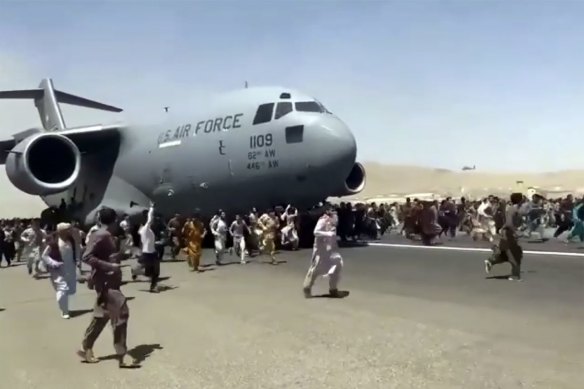
In August, with the Taliban takeover of Kabul, people run alongside a US Air Force transport plane as it moves down a runway of the international airport.Credit: AP
This attempt to retrofit history glosses over the huge amounts of money invested by successive US administrations in military training, governance and development in Afghanistan. But it also relies on the fact that US policy always lacked clarity. As Douglas Lute, a three-star general who led the war effort under the Bush and Obama administrations, told government interviewers in 2015: “We were devoid of a fundamental understanding of Afghanistan ... We didn’t have the foggiest notion of what we were undertaking.”
Australia’s main military engagement in Afghanistan, as part of Operation Slipper, lasted 13 years and was also the longest in our nation’s history. It ended in 2014, in the words of then prime minister Tony Abbott, “not with victory, not with defeat, but with, we hope, an Afghanistan that is better for our presence here”.
That hope had been put to the test in the years since by investigations into the conduct of Australian special forces (which did the bulk of this country’s fighting in Afghanistan), with the Brereton report in 2020 finding that 19 current or former special forces soldiers – a small fraction of the serving force – should face criminal investigation over 39 alleged murders of non-combatants. Australia’s last troops in Afghanistan – 80 personnel in a support role to the Afghan military known as Operation Highroad – departed in June.
Why has a country that was once a stop on the hippie trail and inspiration for the Lonely Planet guide books come to be defined by war and terrorism? How did troops of the US-led coalition end up being there for decades? Did the CIA create the Taliban? And what might the future hold for Afghans?
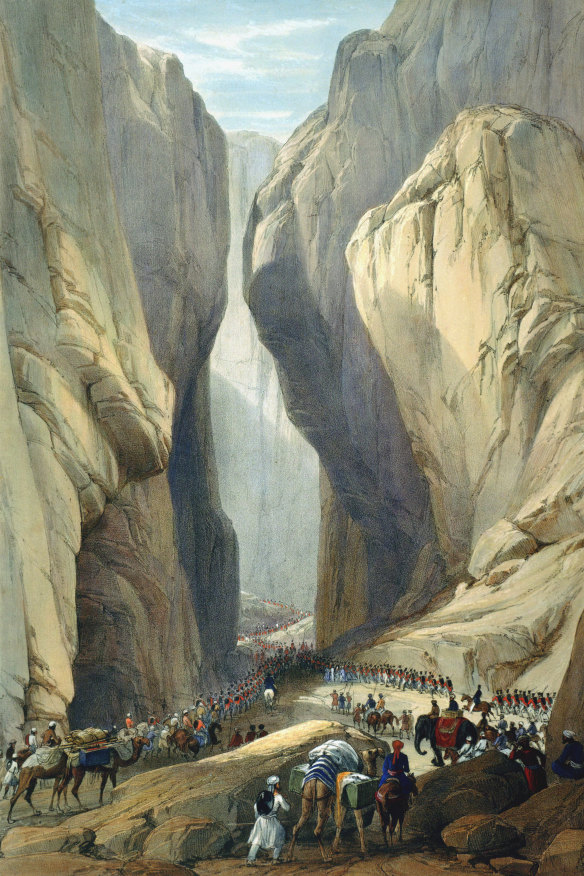
A depiction by army surgeon James Atkinson of British troops entering Afghanistan through the Bolan Pass in 1839. They were massacred in a retreat to the Khyber Pass three years later.Credit: Getty Images
Is Afghanistan really ‘the graveyard of empires’?
The one thing everyone knows about Afghanistan is that it cannot be conquered. As this story goes, every army since Alexander the Great’s in 330BC has had to leave in defeat.
The British, who fought three wars in Afghanistan between 1838 and 1919, did much to popularise the idea of it as inhospitable and unattainable. (Britain lost the first war but the other two could be called draws.) When Arthur Conan Doyle’s Sherlock Holmes meets Dr Watson for the first time, he remarks “You have been in Afghanistan, I perceive”, and later Watson recalls seeing “comrades hacked to pieces at [the 1880 battle of] Maiwand”. In his poem The Young British Soldier, Rudyard Kipling had the last grim word:
When you're wounded and left on Afghanistan's plains,
And the women come out to cut up what remains,
Jest roll to your rifle and blow out your brains
An' go to your Gawd like a soldier.
Three things should be said about this account. Firstly, while travellers and mapmakers had for centuries talked about “the land of Afghans”, or Afghanistan in Persian, there wasn’t a state called Afghanistan until the 18th century. Secondly, by that time the area had been conquered repeatedly by Persians, Arabs, Mongols and Indians – peoples whose history is not always closely studied in the West.
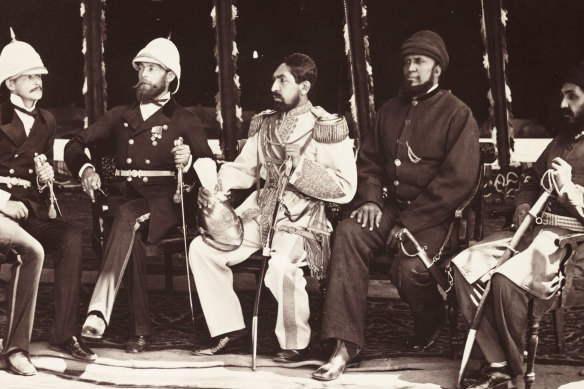
British diplomat Major Sir Pierre Louis Napoleon Cavagnari (second from left) was set to take up the post of British envoy in Kabul when the British residency came under attack in 1879 and he was killed, leading the British to resume war in Afghanistan. Credit: Getty Images
Thirdly, and most importantly, Afghanistan is a place on the edge of every place, a landlocked crossroads at the easternmost limits of the Middle East, the westernmost limits of the Far East, the northernmost limits of South Asia and the southernmost limits of Central Asia. Empires haven't been killed there, but they have often found the end of their reach.
This has meant that, again and again, they have sought controlling influence over Afghanistan’s affairs without having to rule there, or as Britain’s viceroy in India, Lord Curzon, put it in 1906: “We do not want to occupy it, but we also cannot afford to see it occupied by our foes.”
What about the people who live there?
“As an Afghan you are always more than one thing: your kin, your tribe, your ethnicity and the place you were born ... As a foreigner, you can never truly understand what it means to be an Afghan.”
So wrote Abdul Salam Zaeef, one of the founders of the Taliban. At a crossroads, one often encounters a kaleidoscope of people, and Afghanistan has long been home not only to Pashtuns such as Zaeef (once the only people the name “Afghans” referred to) but also Persian-speaking Tajiks and Hazaras, Turkic-speaking Uzbeks and at least a dozen other ethnic groups.
Its remoteness also gave it allure for Western travellers. In 1955, to promote its new line of go-anywhere jeeps, Land Rover sponsored the Oxford and Cambridge Far Eastern Expedition, which saw graduates travel overland from Europe along the long-defunct Silk Road. They were supplied with film to record their journey by a young producer at the BBC, David Attenborough.
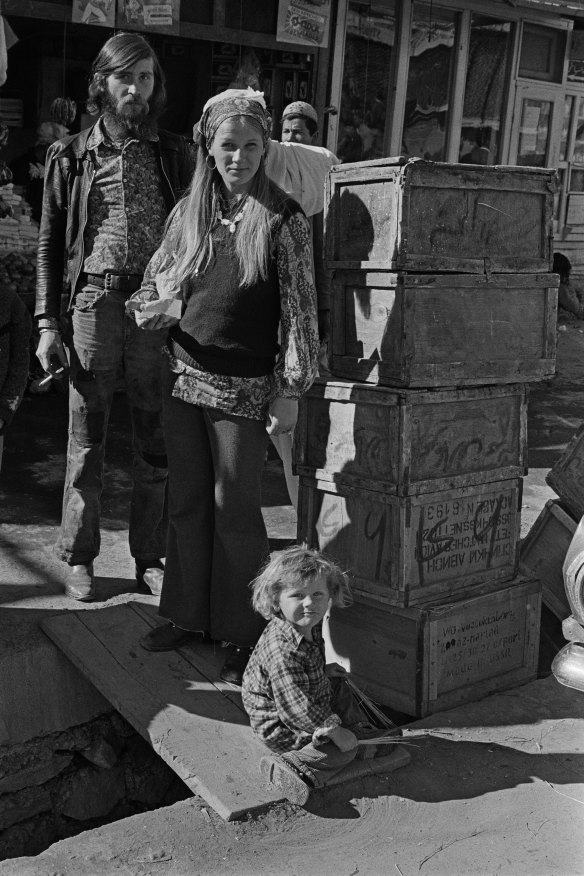
A hippie family in Afghanistan in 1971.Credit: Getty Images
Programs such as the ones created from their footage and books such as Eric Newby’s A Short Walk in the Hindu Kush – a mountain range that runs through Afghanistan – inspired waves of young people to set off on a quest to the “mystic East”. Eventually, this would become the “hippie trail”, featuring the hashish Afghans had always grown and smoked.
One visitor particularly awestruck by the country’s cities, mountains and wilderness was Tony Wheeler. He and his wife Maureen drove across Afghanistan en route from London to Sydney and wrote a booklet about the journey, Across Asia on the Cheap, in 1973, effectively founding the Lonely Planet publishing empire.
In the ’60s and early ’70s, visitors would have found traditional rural societies as well as cities where young Afghans wrestled with modernity in all its forms, from Marxism to the miniskirt.
Indeed, it is said that when short-lived national security adviser H.R. McMaster wanted to convince Trump that the country was not irredeemable and that troops should be kept there, he showed him a photo of three miniskirted students on a Kabul street in 1972.
There was one other constant in Afghan life: Islam. For the hippies it would have been part of the exotic furniture. But as the 1970s progressed and conflict and dictatorship reared their heads, for many Afghans it became the last safe space for political activity.
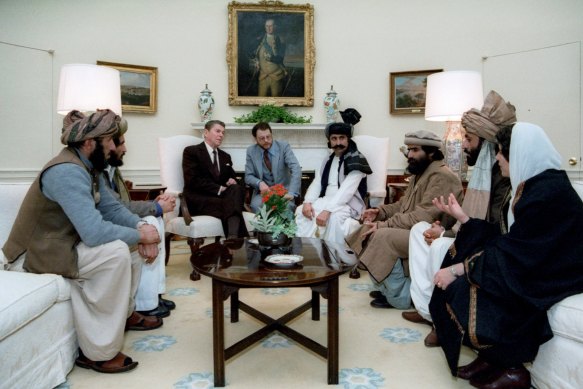
US president Ronald Reagan meets an Afghan delegation at the White House in 1983. While Reagan would later receive mujahideen leaders at the White House, only one of the Afghans seen here is a combatant - Mohammad Ghafoor Yousafzai, third from right. Credit: Wikimedia Commons
Why did the Americans get interested?
When we look at a map today, Afghanistan is bordered to the north by a number of other Central Asian ’stans. But for most of the 20th century those republics were part of the Soviet Union, ruled from Moscow. Just as the British in India had kept a nervous eye on the Russian Empire during the 19th century in what became known as The Great Game, after World War II the US saw Afghanistan through the lens of its Cold War “domino theory”, where the fall of one country to communism would mean the same for its neighbours.
By the late 1970s, despite investment by Washington in agriculture, schools and power plants, Moscow had the upper hand, and in 1978 a coup brought communists to power in Kabul. Their efforts to supplant tribal authority and enact land reform provoked resistance. At first, Moscow refused to become directly involved but, after a second coup in September 1979, Soviet troops entered Afghanistan to install a loyal government, closing the border and forcing “hippie” travellers to make a detour.
The Soviet invasion presented Washington with an opportunity to create a Vietnam-like quagmire for Moscow. US president Jimmy Carter had already begun covertly funding anti-communist militants in Afghanistan through the CIA’s Operation Cyclone. The invasion prompted the US-led boycott of the Moscow Olympics. Under Carter’s successor, Ronald Reagan, Cyclone’s budget would grow from hundreds of thousands to hundreds of millions of dollars a year, and those doing the fighting against the Russians would bring a new word into the English lexicon: mujahideen.
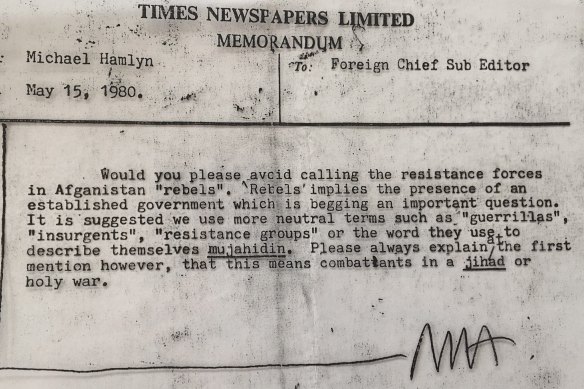
Michael Hamlyn, a correspondent for The Times of London, explains a new word to editors.
Today, when the word jihad (in this context, a war Muslims consider just) has become feared around the world, it is jarring to hear Reagan refer to the mujahideen – the plural of the Arabic word mujahid, or “one who undertakes jihad” – as “the true representatives” of “a nation of heroes”.
Cyclone's funding would be added to by Muhammad Zia-ul-Haq, the dictator of neighbouring Pakistan, and the oil-rich Arab monarchies of the Persian Gulf. By the time the Soviets finally withdrew in 1989, billions of dollars' worth of weaponry and equipment had flooded an impoverished nation where unified government was a memory.
In the 1980s, millions of Afghan refugees fled south into Pakistan’s north-west frontier, largely populated by Pashtuns with strong tribal connections to Afghanistan. The north-west’s main city, Peshawar, became the gateway for those seeking to join the fight to the north.
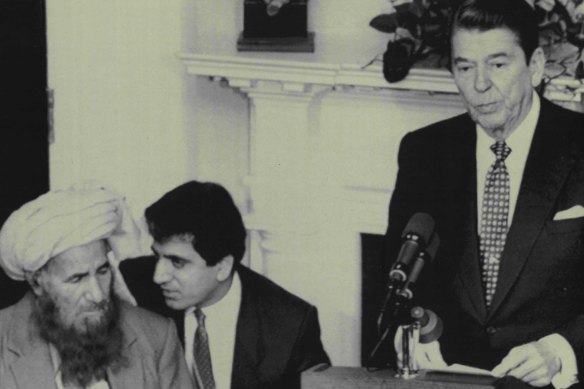
November 12, 1987: US president Ronald Reagan tells a White House audience that mujahideen leader Yunus Khalis (left) represents "a nation of heroes". Translating for Khalis is State Department official Zalmay Khalilzad, later the Trump administration's envoy to Afghanistan.Credit: AP
Who are the Taliban? How are they linked to Osama bin Laden?
The rhetoric of the war against the “godless communists” meant the mujahideen had always included Afghan youths who were originally students of Islam rather than warriors. The Pashtun word for such a student is talib, and taliban is plural.
When the communists in Kabul finally fell in 1992, only to be replaced by ethnic and party-based warfare between the mujahideen, a number of these students in 1994 began an armed movement in southern Kandahar province to end internecine strife, making rigid application of Islamic doctrine and courts their hallmark. Swearing allegiance to a religious teacher and mujahid called Mohammed Omar at a tiny whitewashed mud mosque in the village of Sangisar, they took the name Taliban.
Above: Osama bin Laden (right) with Egyptian Ayman al-Zawahiri, who leads al-Qaeda today, in 2003. Both are dressed as Afghans, though they are Arabs.
For war-weary Afghans, especially in the rural and majority-Pashtun south, the destruction of arms stockpiles in the name of national unity as well as calls for an end to bribery and lawlessness resonated strongly. Within two years the Taliban had swept north into Kabul and declared a new state, the Islamic Emirate of Afghanistan. It would be formally recognised by three countries: Pakistan, Saudi Arabia and the United Arab Emirates.
In a fateful decision, they agreed to grant him safe haven.
Another group had been disenchanted by the descent into factional war: Muslims, particularly those from Arab countries, who had formed a kind of international brigade against the Soviets. In 1988, a number of these “Arab Afghans” became a clandestine Islamist group called al-Qaeda (“the Base”).
After the Soviet withdrawal and with foreign funding drying up, many would go home or move to other war zones in the Muslim world. But one would eventually come back: Osama bin Laden, al-Qaeda's Saudi Arabian founder. By the time he and his followers returned in 1996, he was a fugitive from US and Saudi authorities and the Taliban were rulers. In a fateful decision, they agreed to grant him safe haven.
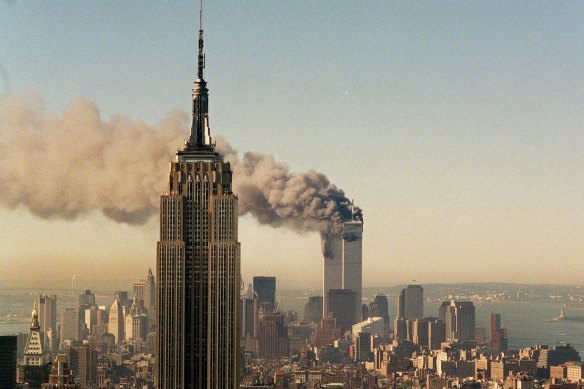
The twin towers of the World Trade Centre burn behind the Empire State Building in New York, after the terrorist attack of September 11, 2001.Credit: AP
Was the war in Afghanistan always unwinnable?
It is unlikely we will ever know for certain how much the Taliban leadership knew about al-Qaeda's horrific plan to use passenger jets as explosive devices targeting the World Trade Centre and the Pentagon on September 11, 2001. But by the time the US and its allies began their "war on terrorism" that October, both the Taliban and al-Qaeda were in their sights.
It was clear that this would mean an end to the Taliban’s “Islamic Emirate”. But what else it might mean seems to have been unclear to even the most senior political and military planners of the US-led coalition.
There were few places the Taliban could look for sympathy. Their rule had become a byword for religious oppression, excluding women from public life and girls from education, banning traditional and modern pastimes from kite-flying to television and meting out savage punishments in the name of Islam. Taliban officials’ expressions of support for Kashmiri Muslims fighting Indian rule, Chechen Muslims fighting Russian rule and Uighur Muslims in Xinjiang fighting Chinese rule alienated those regional powers. The destruction of two giant 6th-century statues of Buddha in Bamiyan in central Afghanistan set the seal on the Taliban’s reputation for barbarism.
But just as invading Afghanistan showed the limits of Washington's reach, overthrowing the Taliban exposed the country's old divisions; the power struggles of the mujahideen leaders returned. At an assembly to ratify a new constitution in 2003, a young woman called Malalai Joya reminded them of their role in the bloodshed of the 1990s, as this clip shows, before she was ejected from the assembly:
Caught between a series of elected governments dependent on Western support and an insurgency that wouldn’t end, US president Barack Obama announced a “surge” that brought foreign troop numbers in Afghanistan to 130,000. But after the killing of Bin Laden in Pakistan in May 2011, both the political and public appetite for such a large commitment waned.
The Taliban have insisted all along that they are the legitimate government of Afghanistan.
The Taliban kept up attacks on foreign and Afghan forces and a campaign of terror against civilians, using the long Pakistan frontier as a rear base just as the mujahideen had against the Soviets.
The Taliban have insisted all along that they are the legitimate government of Afghanistan. But the seeds of their return to power were sown when US defence secretary Robert Gates revealed in June 2011 that Washington was talking to the insurgent group. By 2013, the US had withdrawn most of its troops and the Taliban had been allowed to open a “negotiations office” in the Gulf state of Qatar. In February 2020, the US’s Zalmay Khalilzad and the Taliban’s political leader Abdul Ghani Baradar signed an accord there aimed at finally ending the US invasion.
In that document, Washington had to adopt a contorted diplomatic formula to describe those it was dealing with: “The Islamic Emirate of Afghanistan which is not recognised by the United States as a state and is known as the Taliban.” But the reality was simple: the Taliban were back in the geopolitical game. And their rivals had made their presences felt, too – not least a local version of the so-called Islamic State, which had been carrying out bombings and attacks, even hitting Kabul, long before the US withdrawal.
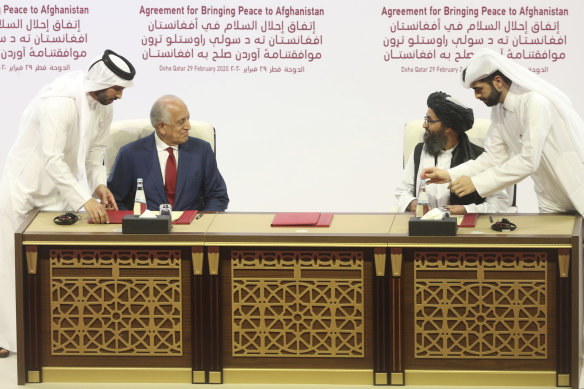
US envoy Zalmay Khalilzad (left) and Taliban leader Abdul Ghani Baradar sign the "Agreement for Bringing Peace to Afghanistan" in the Qatari capital Doha.Credit: AP
So, what could happen now?
It is unlikely that the Taliban’s return to power will be a carbon copy of their first rule, but the ways in which it might vary depend on three factors: how much the Taliban have changed in the past two decades; how much Afghan society has changed; and how much the attitudes of the international community have changed.
The Taliban still adhere to their belief that a punitive, puritanical reading of Sunni Islam under the leadership of a “commander of the faithful” and his select coterie of advisers is the best way to unify Afghanistan and are still likely to continue to deal with opposition to their rule and policies with draconian corporal punishments. And, despite their commitments to the US, the Taliban retain strong links to al-Qaeda, links that the US contended had allowed al-Qaeda to flourish in Afghanistan in the first place.
If two permanent members of the UN Security Council were to recognise the Islamic Emirate, where would that leave the West?
Meanwhile, a generation of young Afghans who have, however fitfully, been part of a society promising parliamentary representation, diversity and inclusion of women and minorities will be forced to renounce their gains. The ability of Afghan civil society to oppose the kind of oppression that the Taliban meted out in the 1990s was always dependent on international support. Malala Yousafzai, who was shot as a schoolgirl by the Pakistani version of the Taliban and became a Nobel laureate through her campaign for the rights of women and girls, expressed “complete shock” at the Taliban takeover: “I am deeply worried about women, minorities and human rights advocates. Global, regional and local powers must call for an immediate ceasefire, provide urgent humanitarian aid and protect refugees and civilians.”
But her call for a global effort comes at a moment when the international community is deeply divided on questions of democracy and human rights. In the 1990s the Taliban were international pariahs but Washington’s rivals – particularly Moscow and Beijing – may view them differently now. If two permanent members of the UN Security Council were to recognise the Islamic Emirate, where would that leave the West?
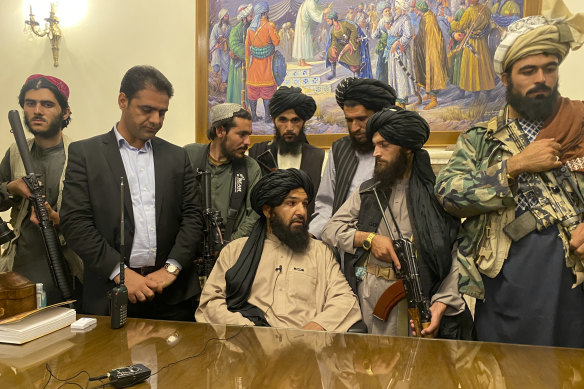
August 15, 2021: Taliban fighters take control of the Afghan presidential palace in Kabul.Credit: AP
After decades of war, Afghanistan has become dependent on billions of dollars in international aid, with more than half the population below the poverty line. Some economists have suggested that a way out of this dependency lies in untapped minerals, with even our own Andrew “Twiggy” Forrest holding talks on copper, hydropower and geothermal projects with now-ousted president Ashraf Ghani in 2020. Others have argued the whole notion of an Afghan mining boom is a mirage given the country’s security situation and lack of infrastructure.
Chinese attempts to begin mining copper in Afghanistan had stalled but in July the Taliban leadership were received by Foreign Minister Wang Yi in Beijing. Already a major investor in neighbouring Pakistan, China may see opportunities for its Belt-Road Initiative and to increase its regional influence. Like Pakistan, the Taliban may be prepared to look the other way on China’s oppression of its own Muslim population in Xinjiang. Taliban spokesman Suhail Shaheen told the South China Morning Post at the time of the meeting with Wang that “China is a friendly country and we welcome it for reconstruction and developing Afghanistan … we care about the oppression of Muslims, be it in Palestine, in Myanmar, or in China … But what we are not going to do is interfere in China’s internal affairs.”
Pakistan, which recognised the first Taliban emirate in the 1990s, sees involvement in Afghan affairs as vital to its security. It also worries that cross-border solidarity between Pashtuns might threaten its territorial integrity. If the current Taliban leadership can allay those concerns as well as curbing support for Islamist militancy within Pakistan, Imran Khan’s government will not hesitate to work with them.
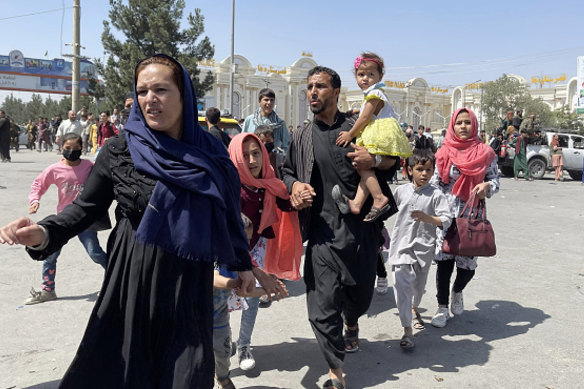
A family rushes to Kabul’s airport after the Taliban takeover. Credit: Getty Images
Throughout the past two centuries, world powers have interfered in Afghanistan for their own reasons. The Taliban’s return and what it chooses to do next will force a reassessment of priorities. But it will pose a more fundamental question: what agency do the Afghan people have in setting the course of their nation?
In a statement prior to entering Kabul in August, the Taliban said: “We want all Afghans, from all walks of life, to see themselves in a future Islamic system with a responsible government that serves and is acceptable to all, God willing.” Yet those brave enough to question unity under the Taliban’s banner have three options: exile, acquiescence or armed resistance. The decisions ordinary Afghans make – and the refugee flows likely to result – will put the international community back at the crossroads.
This explainer was originally published in January 2021 and has been updated to reflect developments.
Let us explain
If you'd like some expert background on an issue or a news event, drop us a line at explainers@smh.com.au or explainers@theage.com.au. Read more explainers here.